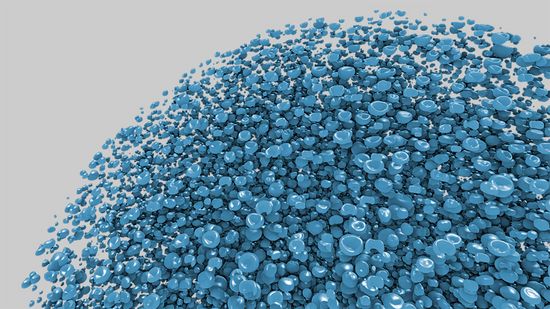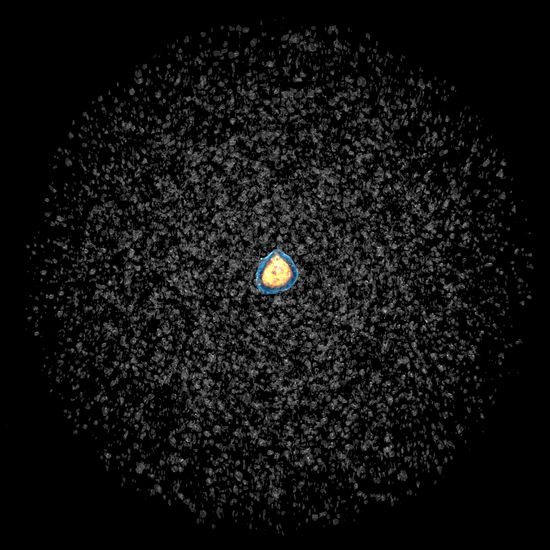ENGINEERING AND CFD
Direct Numerical Simulations of Cloud Cavitation Collapse
Principal Investigator:
Petros Koumoutsakos
Affiliation:
Computational Science & Engineering Laboratory, ETH Zurich (Switzerland)
Local Project ID:
PRACE091
HPC Platform used:
JUQUEEN of JSC
Date published:
Vehicles operating with liquid fluids are the most dominant form of transportation. They account for more than 20% of the world‘s energy resources. Their energy efficient operation is of paramount importance as further reduction in CO2 emissions requires improving the efficiency of internal combustion engines. Precise fuel injection control and enhanced fuel-air mixing however implies high liquid fuel injection pressures. In such conditions, liquid fuel can undergo vaporization and subsequent re-condensation in the combustion chamber. Clusters of vapor bubbles incepted in such flow conditions are referred to as “cloud cavitation”. Their collapse induces pressure peaks up to two orders of magnitude larger than the ambient pressure. When such pressures are exerted on solid walls, they can cause material erosion of the combustion chamber and limit the lifetime of the fuel injectors. Furthermore, the damaging effects of cloud cavitation collapse are an engineering challenge to marine propellers and turbomachinery, yet it can be harnessed in medical applications ranging from kidney lithotripsy to drug delivery.
Cloud cavitation collapse presents a formidable challenge to experimental and computational studies due to its geometric complexity and the multitude of its spatiotemporal scales. Its simulation requires multiphase flow solvers capable of capturing interactions between multiple deforming bubbles, traveling pressure waves, formation of shocks and their interaction with turbulent vortical flows. In typical applications, neither small turbulent structures nor individual cavitation bubbles can be resolved.
Thanks to PRACE and INCITE resources, researchers at the Chair of Computational Science at ETH Zurich (www.cse-lab.ethz.ch) have performed unprecedented large-scale simulations of cloud cavitation collapse with up to 75’000 vapor cavities on resolutions of up to 0.5 trillion mesh cells and 25’000 time steps, outperforming the state of the art by two to three orders of magnitude. The used code is based on the open source package Cubsim-MPCF, developed by researchers at the Chair of Computational Science and winner of the 2013 Gordon Bell award. Various arrangements (i.e., spherical and cylindrical clouds), bubble densities (i.e., tightly and loosely packed vapor bubbles), and distributions (i.e., random and structured locations of bubbles) have been examined. Three main stages of the cloud collapse process have been identified: the initiation of the collapse at the cloud surface (Figures 1 and 3: chaotic initial collapses and cap-like bubble deformations), followed by the formation of a center-directed array of reentrant micro-jets, which finally focus at the center of the cloud and induce up to 25 times higher peak pressures (an indicator for the damage potential) compared to the ambient pressure; as depicted in Figures 2 and 3. These simulations enable further detailed analyses of the shape evolution at various distances from the center, quantification of the evolving velocity and pressure fields and localization of singular events in the process. The obtained results provide unique insights into the problem of cloud cavitation collapse and have the potential to contribute in the development of engineering models for cloud cavitation collapse.

Figure 3. Time evolution of spherical 50’000 bubbles cloud: maximum pressure (left) and its radial location with respect to the cloud center (right). Cloud collapse initiates with stochastic near-surface collapses, provoking an inwards-propagating pressure wave, which then focuses to its peak in the cloud center. Finally, the pressure wave is reflect back towards the surface.
Copyright: CSElab, ETH ZurichOngoing work aims at integrating simulations of cloud cavitation collapse into Direct Numerical Simulations (DNS) of high-Reynolds-number turbulent flows. Furthermore, the researchers will conduct studies of Uncertainty Quantification (UQ) using the non-intrusive Multi-Level Monte Carlo (MLMC) method that will enable robust predictions of quantities of interest. The simulations will also provide databases openly available for the study of fundamental mechanisms and the development of engineering models.
HPC Resources
JUQUEEN, Jülich Supercomputing Centre at Forschungszentrum Jülich, Germany (PRACE Project 091)
FERMI, CINECA, Italy (PRACE Project 09_2376)
MIRA, Argonne National Lab, United States (INCITE Project “CloudPredict”)
Piz Daint, Swiss Supercomputing Center (CSCS), Switzerland (Project s500)
Research Team & Scientific Contact
Prof. Petros Koumoutsakos (PI), Dr. Ursula Rasthofer, Fabian Wermelinger, Dr. Jonas Šukys, Dr. Panagiotis Hadjidoukas, Dr. Diego Rossinelli
Prof. Petros Koumoutsakos
Chair for Computational Science, ETH Zurich
Clausiusstrasse 33, 8092 Zürich, Switzerland
email: petros [@] ethz.ch
www.cse-lab.ethz.ch
January 2016
JSC Project ID: PRACE091

